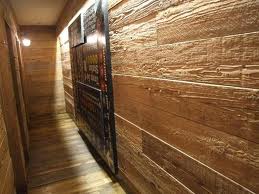Recycled Building Materials
One of the most important ways a home can be built 'green' is the minimization of resources. Any new home, large or small, green or not, requires a great deal of materials to build. Wood, concrete, glass, and a myriad of other natural and manmade materials all go together to create a home. Extracting, processing, and transporting all of that material takes a toll on the environment.
A well-built green home takes resource efficiency very seriously, and one of the ways it does this is through the use of as many recycled materials as possible. Luckily for homeowners, finding recycled materials is easier than ever.
Why is Recycled Better?
Energy Savings: Typically, it requires much less energy to produce products from recycled material than brand-new, virgin materials. This automatically shrinks the materials' environmental impacts; the less energy necessary to produce them, the less pollution and climate-changing gases are released into the environment.Fewer Resources: All building material comes from somewhere, including mining the ingredients necessary for building material, or cutting down forests. These are energy-intensive activities, and often damaging to the natural environment. Using material that's already been extracted and processed eliminates these harmful activities.
Water Savings:As with energy-usage, recycled products also tend to require much less water to produce than brand new materials. Protecting natural waterways from overuse and pollution is critical, and using recycled materials contributes to that goal.
Less Landfill Waste: Most of the material that goes into recycled building products has been diverted from the waste stream; it's what most people refer to as garbage. And garbage usually ends up in a landfill or being incinerated. Why bury perfectly usable material in the ground or burn it and release harmful pollution when it can be incorporated into new material and given a new life?
Reclaimed Building Materials
The most basic form of recycling is the use of 'reclaimed' building materials (sometimes referred to as salvaged materials). These are materials that are taken from old homes or buildings and reused in a new home. They are usually already in a 'finished' state, meaning no processing or manufacturing is needed. Examples of reclaimed products include doors, windows, bricks, plumbing fixtures, and wood trim or flooring.Reclaimed building materials are the epitome of green building. Resources are conserved and material is kept out of landfills. Reclaimed material is often less expensive than brand-new, and the secondhand quality of reclaimed materials can add personality, quality, and value to your home.
Reclaimed wood, for example, is usually salvaged from buildings scheduled for destruction, or 'sinker logs' that sank decades ago during log drives in rivers. The wood from these sources is typically very high-quality, old-growth wood that simply can't be found in newer materials.
Businesses that sell reclaimed building materials are everywhere; doing a quick search online for 'reclaimed building materials' will usually provide you with a list of companies in your area. The Building Materials Reuse Association (http://www.bmra.org/) is another helpful resource. For some people the 'treasure hunt' for the perfect reclaimed material is another part of its charm.
Recycled Building Materials
While reclaimed products is basically the reuse of an existing product, many companies are also incorporating recycled materials into other traditional building materials.There are two kinds of recycled product: Pre-consumer recycled is material made from manufacturing scraps and by-products. Post-consumer recycled is material that has been used by a customer and then recycled. Both are beneficial in reducing energy- and landfill-usage.
There are many examples of recycled building materials, and as you search for the products to construct a new home (or renovate an existing one), it's a good idea to add ''recycled content' to your list of criteria. Some examples of building materials taking advantage of recycled ingredients are:
Brick: Can be made with recycled fly ash, a by-product of coal production that is usually landfilled.
Shingles: Many companies are using recycled plastic, metal, and cellulose fiber (paper).
Insulation: Cellulose insulation is typically made of 75-85% post-consumer recycled newspaper and pre-consumer waste. Cotton insulation is often made from recycled cotton textiles such as old blue jeans. Fiberglass insulation can contain as much as 40-50% post-consumer recycled glass.
These are just a few examples of products that can contain recycled content.
Recycled Materials as Part of Your Green Home
Building a green home is like putting together a house-sized puzzle. There are many pieces to this green puzzle. Using recycled materials is just one tiny piece; it's important to remember all of the other pieces that are just as necessary. Low energy-usage, the use of renewable energy, extreme durability, and the ease of recycling materials after their use are just as critical.Together, these things and more will help you create a home that has as little environmental impact as possible while providing you a beautiful place to live and grow.
comments powered by Disqus


























































































































































































